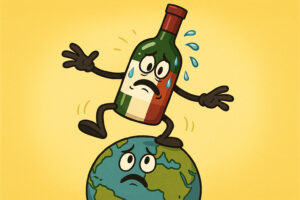
“Divide a territory to bring out its value and increase its appreciation”, said Marco Calaon, president of the Vini Colli Euganei Consorzio, summarizing the meaning of the webinar, “The Euganei Hills DOC towards crus, defining macro-zones through soil and characteristics of the vines”. It is a work in progress based on the first study carried out on the soils and altitudes of the Euganean territory, and has led to identifying six particularly suitable wine-growing areas. Filippo Scortegagna, the agronomist who, together with his colleague Filippo Giannone, and the president of the Consortium, Marco Calaon, is carrying out research on the six macro-areas of the Euganei Hills presented and explained the study.
“I would like to say”, underlined Marco Calaon, president of the Consorzio Vini Colli Euganei, “that we are motivated to continue this work, which must be more and more accurate and aimed at identifying real crus, so that these become a valid tool, available to companies, to fully understand the many characteristics of the Euganei Hills. We are talking about a small territory, and dividing it into six areas will allow us to go into even more detailed aspects. In this case, this is how division is actually an opportunity to increase the value of an area”.
Filippo Scortegagna, together with Filippo Giannone, are the agronomists carrying out research on the six macro-areas of the Euganei Hills. After having outlined the morphological characteristics of the Euganei Hills, Scortegagna said that the focus of the study primarily considered the climatic part, in this first step. He also pointed out that the macro-areas, at the center of the research, have been identified and divided on the basis of environmental conditions.
The first is the Northern Area, which has a typical Piedmont climate – there are many chestnut trees, a good amount of rainfall, and lush vegetation, maximum altitude, around 250 meters. Then the Eastern Area, morning sun exposure, relatively lush vegetation, slightly lower rainfall than in the northern area, climate is more varied with an incline from the foothills to warmer climate, maximum altitude 200 meters. Next, the Western Area, all day sun exposure, warmer temperatures, not excessive rainfall, vegetation close to the Mediterranean scrub, but does not exclude forests, a maximum altitude around 270 meters. We then move to the Central Area, which is characterized by Monte Venda, the highest peak of the Euganei Hills - 601 meters - which acts as a physical barrier to the air currents arriving from the north; thereby, creating a clear division between the north and south in the entire area. Temperatures are lower while the amount of rainfall index is quite high; altitude is over 270 meters. The Southern Area, instead, has all day long sun exposure; the climate is warmer with Mediterranean characteristics and the vegetation well, which features holm oak, broom and oak trees. Rainfall is very low, maximum altitude is 270 meters. Finally, the Valli Area, the entire area surrounding the six macro-zones, in which we find many climatic similarities.
Some of the most interesting data the agronomists have collected in their research include definitely the repercussions on viticulture in the area. “In an area of just 2.500 hectares of vines out of the 20.000 total”, Scortegagna explained, “the variation in degrees on an annual basis reaches even two Celsius degrees. Therefore, it follows that from a botanical point of view, we find chestnut trees in the north and caper plants in the south. Two degrees may seem very few, but actually, this variation affects the environment quite a lot. We also found that the phenologic variability of the Merlot grape budding reaches even up to 18 days between the two opposite parts of the area. There are also great variations on the harvest periods monitored on the same grape starting from 2007, as it reaches 26 days earlier in the Southern area”. According to the agronomist, these data prove the prevailing importance of climatic determinants over soil factors. And, this is the reason climate monitoring will be increasingly significant even in small areas.
“This research has once more highlighted the richness of the Euganei Hills area. It has highlighted the various characteristics that clearly and distinctly characterize every single macro area identified”, Lisa Chilese, communication manager of the Consorzio Vini Euganei Hills commented. “We invite those who produce and live in the Euganei Hills to reconnect and become aware once again of the value and marvels of this territory. To those who have instead the task of narrating the Euganei Hills, I would recommend not to trust what we have said, but to reach out to the Euganean people and see for themselves the beauty and values that distinguish us”.
Copyright © 2000/2025
Contatti: info@winenews.it
Seguici anche su Twitter: @WineNewsIt
Seguici anche su Facebook: @winenewsit
Questo articolo è tratto dall'archivio di WineNews - Tutti i diritti riservati - Copyright © 2000/2025